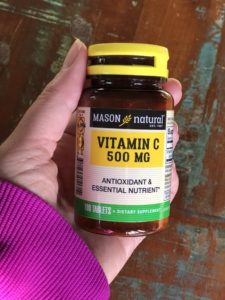Water Bottle Collection
Which water bottles we chose, how we use them, and where to get yours. This isn’t an article about the best water bottles, you can decide which ones are best for you. I just wanted to share the different ones we use and why so you can make informed decisions when you want to add to your water bottle collection. I have included some links to bottles or backpacks so you can get details about them and see what I’m talking about. They are not links to encourage online shopping, just to be informative. See the section below regarding the value of shopping in-person at REI.
YETI® Stainless Steel Water Bottles
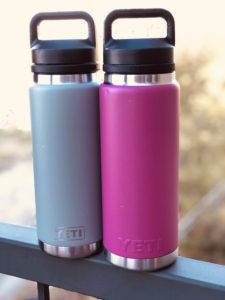
Our YETI Stainless Steel Reusable Water Bottles are also dishwasher safe
We chose the YETI® brand primarily because they are dishwasher safe. Other similar brands are not, and I don’t like to hand wash anything, so this was very important to us. However, many people put stickers on their water bottles, therefore, they need to wash them by hand. That’s why we don’t have stickers on ours.
The other important factor for choosing a YETI® water bottle is because it is important to us to have COLD water. Having an insulated water bottle was a priority for us. It makes it heavier, but we were willing to live with that drawback…initially. Then we started hiking longer, going further, then the weight can be a bigger negative than having water that isn’t cold.
YETI® and similar insulated stainless steel water bottle brands are fantastic for keeping your liquids cold for long periods of time. We chose the 26-ounce size bottle with what’s called a chug cap. It’s like a regular plastic water bottle opening. The cap includes a handle for easy carrying. They have other options with straws and flip-top lids. I didn’t want to keep a straw clean, so we chose bottles without straws.
I bring this one on short walks and carry it in my hand. For longer hikes, it fits in my backpack or on the side pouch of my backpack for easy access. It’s big but not too big. It’s 100% leakproof.
The downside is that it’s heavy. Therefore, our next purchase.
Nalgene Hard Plastic Water Bottles
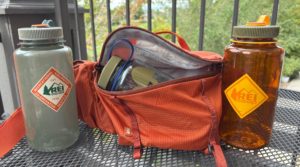 We originally bought a 32-ounce Nalgene bottle to carry extra water. Nalgene bottles are made of hard plastic, and they are not insulated. Michelle got a small waist pack to be able to carry this size bottle, and it fits in there perfectly. Her YETI® water bottle is too big. Sometimes you don’t want something in your hand when you are hiking so you can use your hands to stable yourself when you are climbing. Her pack is called the REI Trail 5 Waist Pack in case you want to see what it looks like.
We originally bought a 32-ounce Nalgene bottle to carry extra water. Nalgene bottles are made of hard plastic, and they are not insulated. Michelle got a small waist pack to be able to carry this size bottle, and it fits in there perfectly. Her YETI® water bottle is too big. Sometimes you don’t want something in your hand when you are hiking so you can use your hands to stable yourself when you are climbing. Her pack is called the REI Trail 5 Waist Pack in case you want to see what it looks like.
We now have a couple of Nalgene bottles, and we use them to bring extra water. We keep them in our YETI® cooler. They come in a wide or small mouth. I recommend the wide mouth so you can easily put ice in it. If you don’t like drinking from the wide opening, like us, then you can get this stopper looking thing to make the opening smaller, so the ice doesn’t slam into your face when you are drinking. Yeah, you know what I’m talking about.
These are completely leakproof. They are dishwasher safe. Again, we don’t put stickers on these either but most everyone else does.
The downside is that they are not insulated so they don’t keep water cold. However, you can fill your Nalgene with ice, then add water, and you’ll get more water as it melts. So, this makes it good for shorter walks. Plus, it’s not too heavy.
Other Stainless Steel Water Bottles
We do have a couple of other stainless-steel water bottles we’ve collected over the years. They are smaller and fit in the cup holders in our vehicles. Some are the YETI® brand. Stainless steel is great for cold or hot beverages. I like the small size. I take these on short walks or offer them to our friends to use when they come to visit. Everyone needs a water bottle nearby in our warm climate. Read my post about Grand Junction weather and Summer Weather in Grand Junction.
Obviously, there are all sorts of water bottles out there. I’m just letting you know which ones we have and why. If you are ready to purchase some while you are here in Grand Junction, I highly recommend you shop at our local REI to choose the best water bottle that will work for you and your intended use.
Emma has a huge Hydro Flask water bottle and she got a special cup holder expander so she can keep her large bottle secured next to her while she’s driving.
Serious Hikers Use Water Bladders, also Called Water Reservoirs
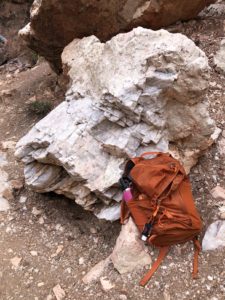
Michelle’s Flash 22 REI backpack resting on rocks near Mica Mine trail in Grand Junction
We learned the hard way one time when we ran out of water. It was my birthday (May) and we hiked the Palisade Rim Trail with our daughter Emma. Because she’s a fast hiker and we are not, she let Michelle or I lead the way, set the pace. Well, let’s just say we got off the trail, twice, and our 2-hour hike turned into more like a 3.5 hour hike. And this trail has a steep upgrade at the beginning. We ran out of water at the top and still needed to come down.
Michelle’s small REI backpack (called a Flash 22) has a spot for a water bladder (water reservoir), and we went to REI after this trip to buy one. We keep it in the freezer, so it doesn’t get bacteria growth, and it will be ready to go when we need it. It holds 3 liters of water. If we go on a longer hike, like 3-4 hours she uses it. It’s a better way to carry more water. Hydration packs are designed to make drinking convenient and efficient. You don’t have to stop, or even slow down, to take a sip of water; you simply grab the drink tube that’s connected to the water reservoir. You don’t need to stop and pull a water bottle from a backpack.
Emma uses her small hiking vest that holds a water bladder all the time, even for short walks around town or when we go to the Palisade Farmers Market. REI has a large selection of backpacks, hydration packs, hydration vests, hip packs, and water carrying backpacks you can consider.
Why Buy at REI?
You’ve got to go to REI and ask for Josh Kolb, our son-in-law. He’s a local expert and can explain, in detail, the pros and cons of all water bottle styles, sizes, brands and their reliability. You get to pick out the one you like the best, in your favorite color, and bring it home. It’s a much better experience than going online, reading the ratings and reviews, hoping you chose the right one, and then waiting for it to be shipped to you.
The best thing about shopping for your water bottles at REI is that you get valuable LOCAL advice. If Josh isn’t working when you stop in, that’s ok. Everyone there is very knowledgeable, helpful, and friendly.
The reason we buy our water bottles and other outdoor gear there is because of their generous return policy. If you don’t like it, or it doesn’t work as expected, you can bring it back. No need to package it up and bring it to the post office or a shipping location. Just walk through the door and they’ll take care of you. Ask me about the time we had 45 minutes to buy Emma a mountain bike when we brought her to CMU for college. We went straight to REI because we knew she could easily return it if it wasn’t right. I mention REI in our post about Parent Tips for CMU families.
I also highly recommend you become a REI Member to take advantage of special sale coupons and an annual rebate check based on how much you’ve purchased. And if you want to go one step further, Josh can explain the multiple benefits of having the REI Credit Card. It has a fantastic sign-up offer! Grand Junction REI is located at 925 Independent Ave, Grand Junction, CO 81505.
Types of Coolers
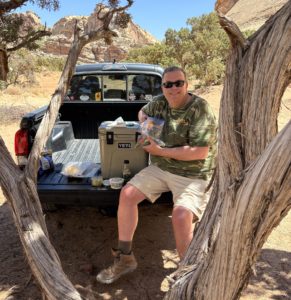
We ate a picnic lunch in a campground under the shade of a tree near Goblin Valley in Utah
On a related note, I wanted to share two things we learned about our YETI® Roadie Cooler since moving to Grand Junction. The Roadie Cooler is a great size for day trips when you want enough space for beverages, lunch, and snacks and you won’t break your back carrying it. It has a great shoulder strap!
In the beginning, ours wasn’t keeping our items as cold as we thought it would. That’s when Josh asked if we were “pre-cooling it”. What? We had no idea.
The night before, we now put an ice pack in the cooler to start cooling it down. Before we leave, we take that one out and put it back in the freezer. We put fresh frozen packs in the cooler, and we go. That helped but it still didn’t seem like it was keeping our drinks cold for a long period of time.
Then Josh said it’s better to have one large block of ice instead of several smaller ones. When Emma and Josh go on 5-day river trips, they need their food to be kept cold for the entire trip. They can’t afford it to spoil. They buy blocks of ice from the grocery store or a gas station so their large YETI® coolers stay cold!
I also decided that freezing individual plastic water bottles is way better than using our 20-year-old ice packs. LOL. We do this for two reasons. As the ice melts, we now have more clean water available to drink if we need it. And having the thicker frozen bottle is better than the thin ice packs we were using. Now we know!
If we are staying local or won’t be gone the entire day, we have 2 smaller collapsible bag coolers (similar to this one at REI) that do a great job too. Ironically, they were gifts from a lender and a title company, so we didn’t shop for them. But they do the trick to keep up to 6-8 cans or bottles of drinks cold or a couple of snacks, dip or salsa. Plus, they have pockets for napkins, silverware and a garbage bag. I use these bag style coolers to keep drinks cold when I take clients around the Grand Valley. Everyone needs to stay hydrated. You can read my related post about how to avoid altitude sickness and the importance of drinking enough water.
I hope you learned something new about water bottles, and I hope you shop at REI when you are in Grand Junction. If you are coming to the area, let me know if you’d like a tour. I’d be happy to show you around. And yes, we can stop at REI along the way if you want to pick up a new water bottle to use while you are here.
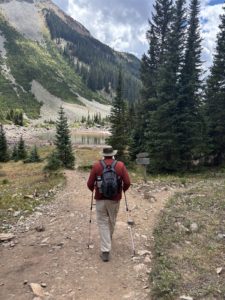
Hiking to Crater Lake near Maroon Bells/Aspen area with my YETI water bottle in my backpack.
Check out REI when you come to Grand Junction!
Are you seriously thinking of moving to Grand Junction? Here’s my suggestion for Getting Started!
PAUL ASPELIN, REALTOR®
GRI, SRES®, CNE
Your Grand Junction Real Estate Expert
Live Your Vacation in Grand Junction!
Follow me on Facebook:
https://www.facebook.com/LiveYourVacationinGrandJunction
Text/Call me at 612-306-9558
Connect with me on LinkedIn or send me an email.
Serving Mesa County and the Grand Valley of Colorado.
© 2025 Paul Aspelin, REALTOR® MovetoGrandJunction.com Copyright protected. All rights reserved.


